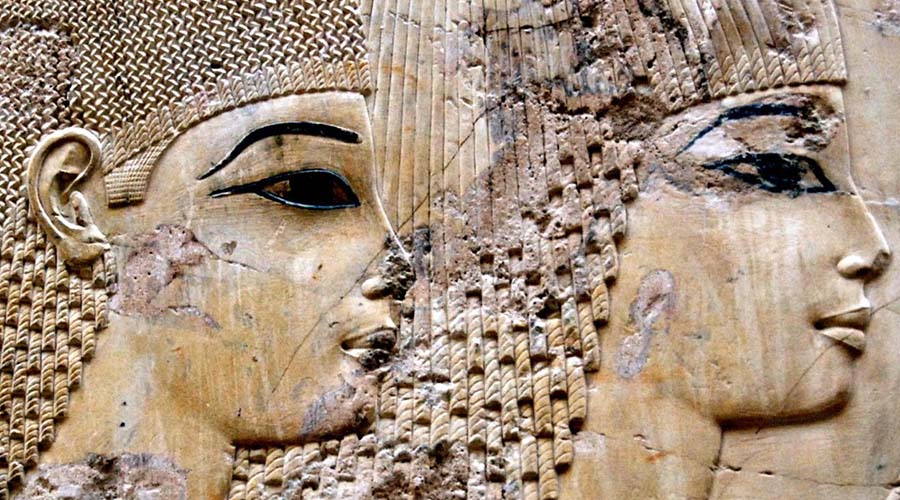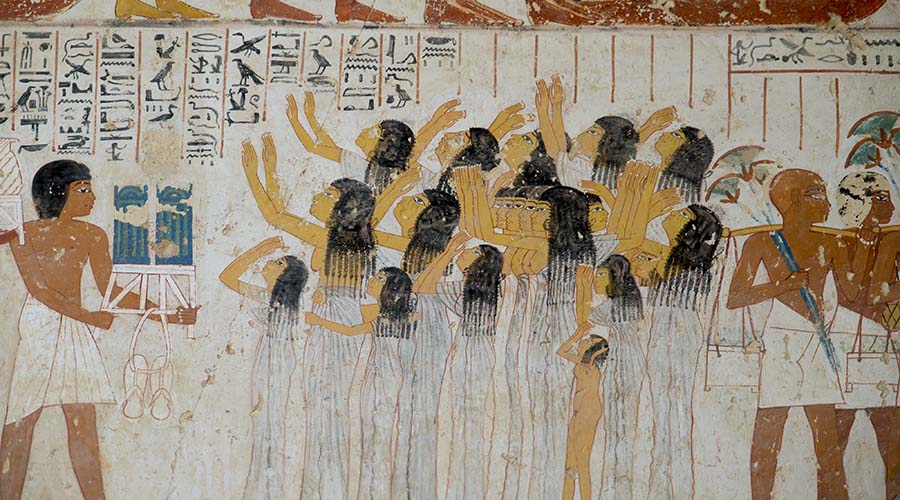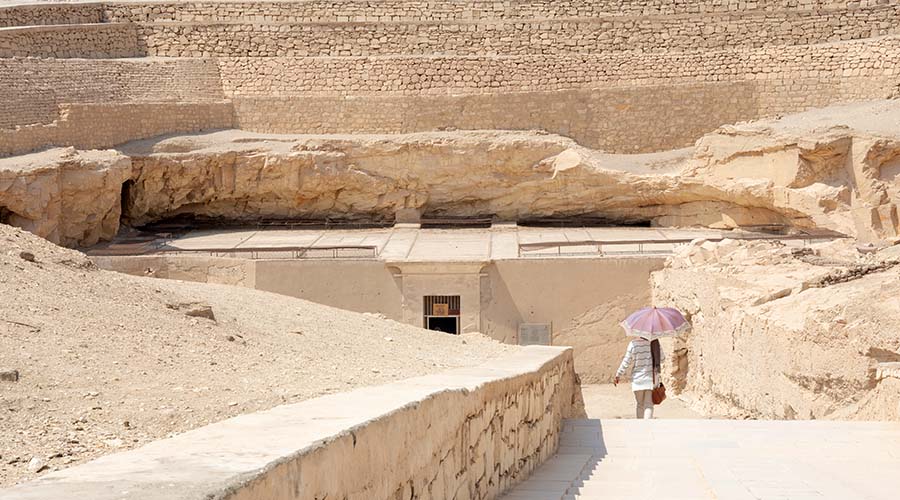Ramose tomb Luxor Egypt TT 55 tours, prices, booking
Ramose tomb Luxor Egypt located in the village area of Sheikh Abd el-Qurna. In fact, Ramose was “Governor of the Town” (Thebes) and Vizier during the Dynasty XVIII transition. It was in the reigns of Amenhotep III and IV. Ramose tomb Luxor indeed reflects his important position in the royal court and. Moreover, it represents the change in style towards “Amarna art”. In fact, it is uncertain whether the deceased ever buried in the tomb. Maybe he followed Akhenaten to his new capital Akhetaten. But no tomb has found for Ramose there. The plan of Ramose tomb is a traditional T-shape. It also built on a large scale with some of the most beautiful relief carvings of any Theban tomb. Furthermore, a wide stairway leads down to the courtyard in front of the tomb.
The entrance also leads into a large transverse hall. Ramose tomb Luxor roof once supported by four rows of eight papyrus columns. Some of these have recently restored. There were a great deal of damage to the tomb, specially to the reliefs depicting Akhenaten. In fact, it was because of a collapsed ceiling. Moreover, this contributed to the preservation of the remaining reliefs. The tomb also usurped by another individual at a later date. The wall on the left of the entrance shows Ramose wearing the gown of a vizier. He consecrates offerings to Amun-Re, Re-Horakhty, Atum and Khepri. Moreover, he followed by his attendants. The scenes of the banquet on this wall indeed are beautiful. They also carved with fine detail on limestone. They left uncolored except for the eyes of the figures.
Further details about Ramose tomb Luxor Egypt:
Each guest, some of them the relatives of the deceased, named in the accompanying texts. These say that Ramose married his brother’s daughter, Meryt-Ptah. The end wall on the south side portrays the funeral procession in two long registers. Moreover, the floor at this wall slopes down into the burial shaft below, which is sometimes accessible. In fact, this wall not carved but its paintings show good color and detail of the funerary goods. They transported to Ramose tomb Luxor with the procession of mourners. They move towards the Western Goddess. The canopic jars in their shrine taken with the sarcophagus to the tomb on sleds. Before them is an unusual scene of the ‘teknu’ – a mysterious part of the funerary ritual. There are also many opinions about what the ‘teknu’ was.
One idea is that it was a priest who wrapped in skins. He transported on a sled in some kind of ritual of rebirth. The others suggest that it was the wrapped internal organs of the deceased. They not placed in canopic jars. The ‘teknu’ in this scene can seen to be the shape of a man crouching, with his feet showing. The second register shows more of the procession with Ramose tomb Luxor furnishings. It also shows burial goods carried to the tomb. A group of mourning women dressed in white robes with their hair loose shown in a well known scene. The scene is at the center of the procession. Furthermore, nine kneeling women wail and cover their heads. It is with ashes and bare chested women. She dressed in yellow and red beat their breasts. Unfortunately the captions for these scenes are incomplete.
More details about Ramose tomb Luxor Egypt:
At the end of the wall the two registers linked together ending before the Western Goddess. It is where the deceased is before his tomb entrance. In fact, the west wall of Ramose tomb Luxor damaged and difficult to recognize. Moreover, it has four unfinished figures of Ramose. The last offering is a bouquet to a king in a kiosk with the traditional nine enemies on its base. The cartouche is that of Amenhotep and the damaged epithet ‘great in his time’. It suggests that the ruler was Amenhotep IV (Akhenaten). Moreover, it portrayed in his earlier years in the formal style of his father Amenhotep III. Behind him sits the goddess Ma’at in the classic style. In the center of the west wall is the entrance to the unfinished inner chamber. It is where Ramose portrayed entering the tomb, with an autobiographical text
On the right of the entrance Ramose seen kneeling prostrated. It is before Amenhotep IV and his queen Nefertiti. They shown in the ‘Window of Appearances’ with the rays of the Aten showering down on them. Moreover, this relief executed in the new style of Amarna art. It also defaced, presumably after Akhenaten’s reign ended. Furthermore, Ramose shown receiving the “Gold of Honor” one of the highest awards in the land. Many courtiers and officials are bowing low before the royal couple. Beyond this scene the wall unfinished. Drawings have sketched in but left uncarved. These show foreign delegates (four Nubians, three Asiatics and a Libyan). They come to pay homage and offer tribute to the king.
Further details about Ramose tomb Luxor Egypt:
In fact, the north wall of Ramose tomb Luxor not decorated. Moreover, the wall to the right of the tomb entrance again decorated with traditional fine reliefs. There is also an Iun-mutef priest. He dressed in a panther skin. It is with a comprehensive list of offerings. They are for the soul of the deceased. Many family members again shown on this wall. There is a statue of Ramose who dressed in his long vizier’s robe. It is with a heart amulet around his neck purified by two priests. In the scene above, Ramose and his wife face three girls holding out sistra and menat. It is to the deceased in another beautiful relief. Next to the entrance Ramose and his wife depicted with offering bringers burning incense.
Entrance to Ramose tomb Luxor:
Ramose tomb opens 8 am to 4 pm in winter. A ticket for Ramose tomb, Userhet tomb and Khaemhet tomb can bought at the ticket office.
















